► The Ford Capri’s been rebooted for 2024
► But the legend dates back to 1969
► We celebrate the car’s best moments
Today is D Day for Ford fans across Europe. The moment they’ve been waiting for is now upon us – a new Capri is launched, some 37 years after the last one fell off the price lists. Here we take a fond look back at its legendary namesake.
You can read all about the new electric SUV elsewhere, here we’re going to try and work out why the ‘Capri’ name is such a legend by turning back the clock and walking through its highlights. Its success wasn’t witchcraft – just the combination of excellent marketing, brilliant value and a great looking product that knocked the opposition dead.
We say ‘just’, but there’s more to it than that. Launched in February 1969 and touted as the ‘Car you always promised yourself,’ by Ford’s genius marketeers, this was Europe’s answer to the Mustang, and that was a roaring success in the USA. The Capri was supposed to be called the Colt (for obvious reasons), but Mitsubishi beat it to the naming rights, and wasn’t in the mood to share.
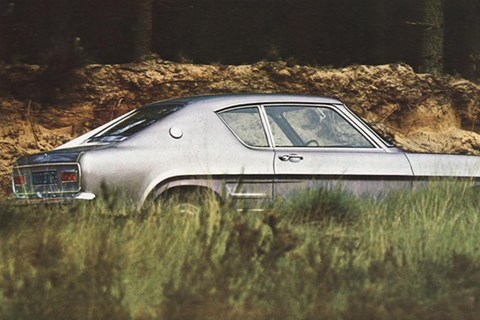
Creating a European legend
The Capri was a hugely important product. As the second product of Ford of Europe it followed on from the Escort in being an all-new pan-European model that would be built across the continent, with very few regional variations. For Ford this made so much sense, with the UK and Germany no longer building competing designs for the same market.
Unlike the car, the name wasn’t really new: In the 1950s, the Americans already had their Lincoln Capri, and on the British market there was the Consul Capri. Later we had the Mercury Capri, which was developed in Australia and was the sad end to a highly promising side-story.
Visually, however, the Ford Capri was completely new – even if the fake air intakes ahead of the rear wheels were an obvious nod to the US model. As can be seen from the image above, the car’s distinctive horseshoe rear window shape came late in its development programme following unfavourable feedback from customers in design clinics.

1969: Ford Capri launched
Sales kicked off in February 1969 after its launch at the Brussels motor show, and Ford soon found itself in the fortunate position of having yet another sales hit on its hands. If the intention had been to replicate the North American success of the Mustang here in Europe, Ford has succeeded in its aims.
Key to the appeal of the Capri was you could get it in so many versions. In the UK, it had Cortina ‘Kent’ engines in 1.3- and 1.6-litre forms and topping the range initially was the unloved Essex V4 in 2.0-litre form. In Germany, the engine range started with a Taunus’s 1.3-litre V4 with 50bhp, and also included a 1500cc with 60bhp and a 1700cc with 73bhp.
The sexier Capris were coming. First was the UK’s 3000GT at the end of 1969. Using the 2994cc 138bhp ‘Essex’ unleashed genuine performance. For just over £1000, you got a 120mph top speed, and 0-60mph of less than 10 seconds. But that was soon eclipsed by Germany’s RS2600 (above), which featured Kugelfischer fuel injection and made 150bhp. It would soon form the basis of Ford’s Group 2 activities in the European Touring Car Championship.
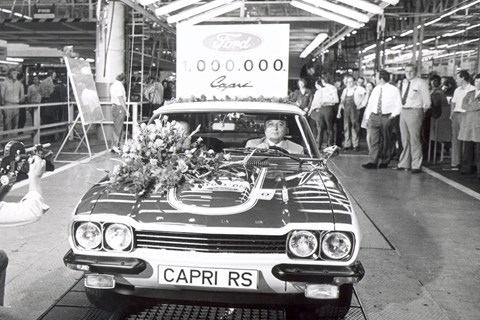
1973: The first million made
The scale of the Capri’s success was was unprecedented for a European coupe. Just four years after its launch, the millionth example rolled off the line – with those canny managers making sure that the exact model to tick over this landmark was a super-sexy RS2600 (above).
In reality, most Capris sold had wheezing four-cylinder engines and would be lambasted by the enthusiast press for being sheep in wolves’ clothing. But that’s not to belittle Ford’s hard work in keeping the Capri on top of its game – a light facelift in 1971 had improved interior ergonomics, unified much of the engine range, and improved the suspension.
It was also the year of the swansong Mk1 Capri, with the RS3100 being launched (with the same power and more torque than the RS2600) and sold in limited numbers. With its ducktail rear spoiler, and exciting performance, this was a Ford to go Porsche hunting in, as ably modelled by three-times Formula 1 world champion Sir Jackie Stewart (below). It was also the storm before the calm…

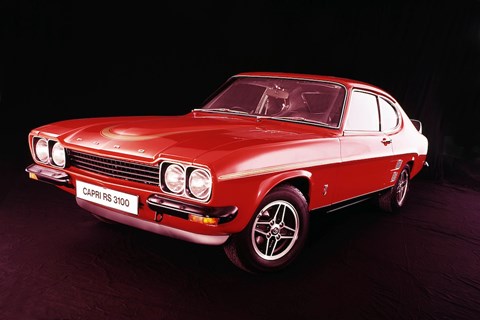
1974: That difficult second album
In February 1974, the Capri Mk2 was introduced. After a run of 1.2 million cars sold, and with the post-1973 mood being rather glum in the wake of the Energy Crisis, Ford appeared to take the Capri into a much more sensible direction. In addition to taming the styling (Peter Stevens once fessed up to designing the Mk2’s headlights), Ford made it a whole lot more versatile with the addition of a hatchback rear, and split folding rear seats.
Ford once again followed the mantra of offering a Capri for all drivers, meaning you could now buy a Capri L, GL or Ghia – just like a Cortina or any other run-of-the-mill model in the range. Sales did take a hit with the new car and, although the 3000S, Ghia and JPS Special edition went someway towards making the Mk2 sexy.

1978: Third time’s a charm
The oh-so sensible Mk2 made way for the Mk3 in what must be one of the industry’s must successful facelifts, ever. Designated Project Carla, the re-invigorated car proved that the Ford stylists had not lost their magic touch. In fact, the only major differences between the Mk2 and Mk3 were its re-profiled bonnet leading edge, ribbed rear light clusters, and wraparound bumpers. Clever, huh?
As before, a wide range of models were offered, once again ranging from the 60bhp 1.3-litre car to the 138bhp 3000S and Ghia models. In Germany, the Capri went racing again, with Zakspeed building a spectacular competition car (below, pictured in 2019) to campaign in Group 5 Endurance events.
Thanks to regulations that effectively only required a passing resemblance between donor car, the wild-looking turbocharged Capri completed a championship-winning season in the DRM (the forerunner to DTM) at the hands of Klaus Ludwig. Once again, Ford had taken the fight to Porsche in motor sport.
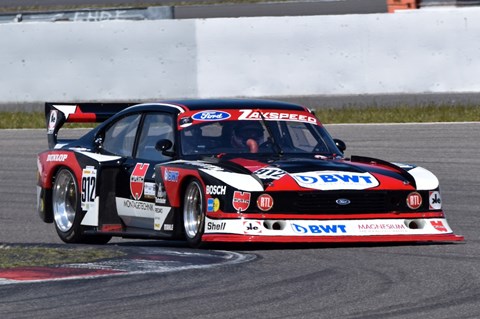
1981: The best for last?
Ford dropped the wheezy old Essex engine in 1981, replacing it with the ‘Cologne’ V6 in 2.8-litre form. Boasting 160bhp and a 0-60mph time of 7.7 seconds, the Capri 2.8 Injection (below) was able, once again, to punch above its weight, and give the emerging generation of hot hatches something to think about.
It should have been the long and final goodbye for the Capri, but it’s now entered into motoring folklore that strong UK sales meant it remained in production long after Ford considered closing it down. Little did we know at the time, that the fitment of this engine would help prolongue the Capri’s life for a further six years.
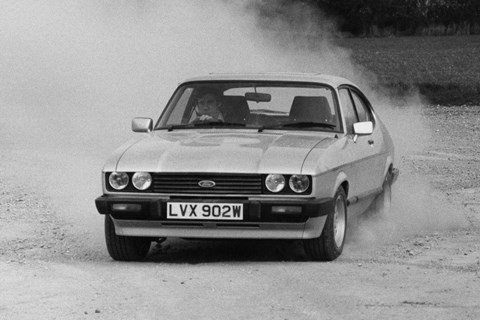
High profile appearances in popular TV programmes such as The Professionals maintained its profile, and buyers lapped them up – so much so that the Capri Injection would outlive the car designed to replace it, the Sierra XR4i. Ford did investigate a new Sierra-based coupe (below), but the idea never got off the ground as the firm wasn’t convinced of the car’s profitability.
Final development was little more than a marketing exercise, with a raft of special editions seeing it into old age – you could buy the Calypso, the Cabaret. But in an era of engine management and digital dashboards, Uncle Henry’s European Pony Car had well and truly past its sell-by date.
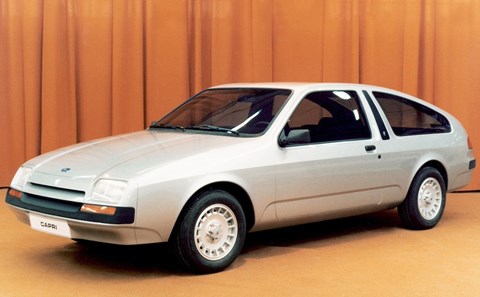
1987: And on to the end
The Capri couldn’t go on forever – and when Ford finally decided to wield the axe in 1987, it decided to see it off in style. The Brooklands Green 280 special edition (below) was concocted to create a buzz around the end of the line. It proved to be a brilliant last hurrah for a much-loved car.
During 1987, Ford built 1038 Capri 280s, and despite minimal upgrades from the standard 2.8 Injection, and this now being in the midst of the hot hatch arms race, they sold like hot cakes. Updates included a limited slip differential, full leather interior with Recaro seats and Pirelli P7 tyres on 15-inch RS alloys.
And with that, this was the end of the Ford Capri – a legend in its own lifetime – until now.

The Ford Capri Story
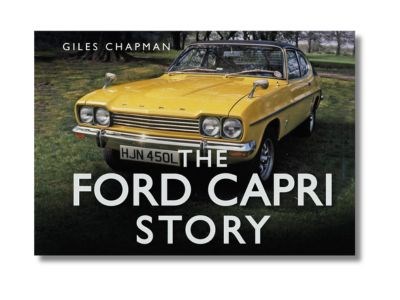
Want to learn even more about the Ford Capri? Take a look at this book detailing its development and life.